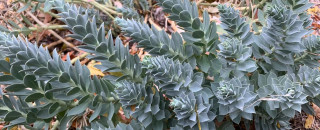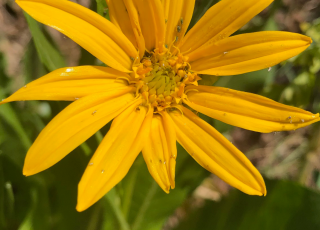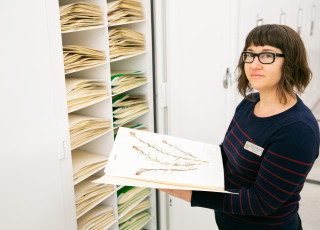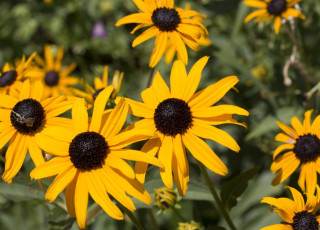The Curious Case of Myrtle Spurge
Myrtle spurge growing in a Salt Lake City yard. Credit: Riley Black
By Riley Black
If you take a walk through the Salt Lake City neighborhoods and hills around our State Capitol, you may see well-groomed gardens boasting a scaly, almost reptilian-looking plant. This is Euphorbia myrsinites, or myrtle spurge, a common form of ground cover that was previously favored by landscapers. But it’s not from anywhere near here. Myrtle spurge hails from regions around the Mediterranean, and its presence in Utah has raised plenty of consternation.
For a time, it seemed like myrtle spurge was a solid choice for “water wise” gardens. The plant grows well in shade, requires little in the way of hydration, grows in disturbed environments, and looks attractive. But myrtle spurge very quickly spread from the home gardens to hillsides along the Wasatch Front, quickly outgrowing and shouldering-out native plant species. The problem has become to frustrating that myrtle spurge is now classified as a noxious weed in Salt Lake County, which has joined the states of Colorado and Oregon in banning sale of the plant.
Some experts describe the situation as “grim.” At present, Mrytle spurge has no predators to prune back its advance, and its hardiness allows the plant to out-grow and out-compete native plants. This in turn affects the organisms – from insects to birds and mammals – that have evolved in tandem with Utah’s plants. Mrytle spurge is also incredibly difficult to remove. Its root systems grow wide underground, meaning that pulling out plants at the surface may not be effective, and even then myrtle spurge emits a sap when injured that can blister human skin.
But looked at another way, the spread of myrtle spurge can lead us to critical questions about how humans are changing the habitats we live in and around. Myrtle spurge tends to take root in places that have already been disturbed by human activity. The plant is taking advantage of opportunities we created in the first place. And given that myrtle spurge is likely to remain as part of local ecosystems, ecologists can watch what new interactions might arise between the plant and other organisms. At the very least, the proliferation of myrtle spurge is a reminder that we should take great care in a matter as seemingly simple as what to plant in the front garden. Small choices can shape the world in unexpected ways, our day to day lives intertwined with the rest of nature.
Riley Black is the author of Skeleton Keys, My Beloved Brontosaurus, Prehistoric Predators, and a science writer for the Natural History Museum of Utah, a part of the University of Utah in Salt Lake City. Our mission is to illuminate the natural world and the place of humans within it. In addition to housing outstanding exhibits for the public, NHMU is a research museum. Learn more.



